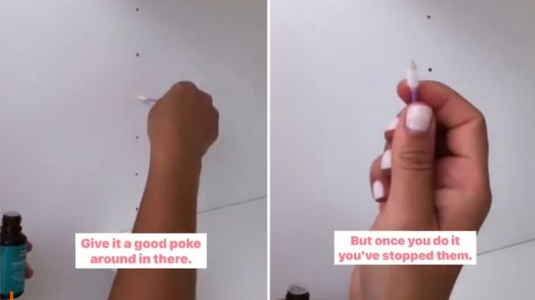Eliminate pantry moths with this surprising tip
By
- Replies 5
Pantry moths, those pesky invaders that seem to have a knack for turning your kitchen into their breeding ground, can be a nightmare for any homeowner.
They can infest your food supplies, forcing you to throw away groceries, and leave you with a massive cleaning task.
But what if you've done all that, and they still keep coming back? The answer could lie in a little-known hiding spot you've probably overlooked.
Professional Organiser Anita Birges has revealed this 'tricky little place'—the shelf support holes in your cupboard.
These tiny, often overlooked holes can serve as a perfect breeding ground for pantry moths, allowing them to return time and time again, despite your best efforts to eradicate them.
But don't despair! Cleaning these small holes is quite straightforward, thanks to one of Birges' ingenious home tips, which she shared on social media.
'All you need to do is put a drop of peppermint oil onto a cotton bud. Stick the cotton bud into the holes one by one and give them a good clean out,' she advised.
‘The great thing about peppermint oil is that it's all natural and doesn't contaminate your food storage area. Peppermint oil not only works to clean out the pantry moths, but also deters them from coming back.’
In the clip, Birges demonstrates the tip and even reveals a moth cocoon she was able to remove as a result of cleaning out the holes.
For those who want to ensure they've completely moth-proofed their pantry, Birges offered an 'extra tip'.
'After you have cleaned out all the shelf support holes, you can cover them up with those little white circle stickers that you can find at Kmart, Officeworks or your local Newsagent,' she suggested.
The tip was well received online, with many expressing relief at finally finding a solution to their persistent pantry moth problem.
'I needed to see this today. We've had them for two weeks and I can't seem to get rid of them!' one woman commented.
Another follower shared an additional pantry moth deterrent tip. 'I also leave a couple of peppermint tea bags on the shelves to keep them away,' she said.
While cleaning out the shelf support holes can help get rid of existing infestations, preventing future ones requires a bit more effort. Here are some additional tips:
Remember, the key to dealing with pantry moths is persistence. With these tips and tricks, you'll be well on your way to a moth-free pantry.

Have you tried this trick, or do you have other tips for dealing with pantry moths? Share your experiences in the comments below.
They can infest your food supplies, forcing you to throw away groceries, and leave you with a massive cleaning task.
But what if you've done all that, and they still keep coming back? The answer could lie in a little-known hiding spot you've probably overlooked.
Professional Organiser Anita Birges has revealed this 'tricky little place'—the shelf support holes in your cupboard.
These tiny, often overlooked holes can serve as a perfect breeding ground for pantry moths, allowing them to return time and time again, despite your best efforts to eradicate them.
But don't despair! Cleaning these small holes is quite straightforward, thanks to one of Birges' ingenious home tips, which she shared on social media.
'All you need to do is put a drop of peppermint oil onto a cotton bud. Stick the cotton bud into the holes one by one and give them a good clean out,' she advised.
‘The great thing about peppermint oil is that it's all natural and doesn't contaminate your food storage area. Peppermint oil not only works to clean out the pantry moths, but also deters them from coming back.’
In the clip, Birges demonstrates the tip and even reveals a moth cocoon she was able to remove as a result of cleaning out the holes.
For those who want to ensure they've completely moth-proofed their pantry, Birges offered an 'extra tip'.
'After you have cleaned out all the shelf support holes, you can cover them up with those little white circle stickers that you can find at Kmart, Officeworks or your local Newsagent,' she suggested.
The tip was well received online, with many expressing relief at finally finding a solution to their persistent pantry moth problem.
'I needed to see this today. We've had them for two weeks and I can't seem to get rid of them!' one woman commented.
Another follower shared an additional pantry moth deterrent tip. 'I also leave a couple of peppermint tea bags on the shelves to keep them away,' she said.
While cleaning out the shelf support holes can help get rid of existing infestations, preventing future ones requires a bit more effort. Here are some additional tips:
- Store food in airtight containers: Pantry moths can easily chew through cardboard and plastic bags. Storing food in airtight containers can prevent them from reaching it.
- Regularly clean your pantry: Regular cleaning can help you spot an infestation early before it gets out of hand. Be sure to clean all corners and crevices where moths could hide.
- Dispose of infested food immediately: If you find pantry moths in a food item, dispose of it immediately to prevent the moths from spreading to other foods.
- Use pantry moth traps: These traps use pheromones to attract male moths, disrupting their breeding cycle.
Remember, the key to dealing with pantry moths is persistence. With these tips and tricks, you'll be well on your way to a moth-free pantry.
Key Takeaways
- Pantry moths can hide in the shelf support holes of cupboards, which is a spot often overlooked during cleaning.
- Professional Organiser Anita Birges recommends using peppermint oil on a cotton bud to clean these holes, as it acts as a natural deterrent for pantry moths.
- To further prevent moths from returning, it's suggested to cover cleaned support holes with white circle stickers from stores like Kmart or Officeworks.
- The cleaning tip has been well received online, with many expressing relief and additional tips such as leaving peppermint tea bags on the shelves to deter moths.
Have you tried this trick, or do you have other tips for dealing with pantry moths? Share your experiences in the comments below.








